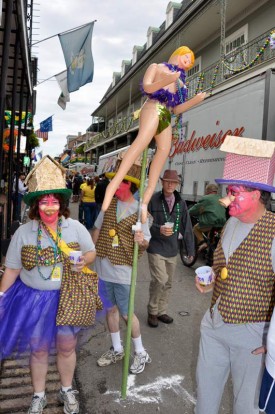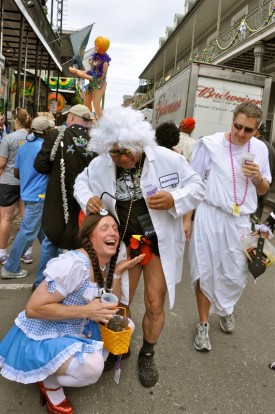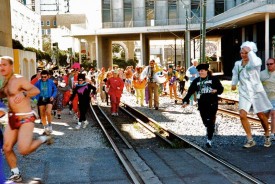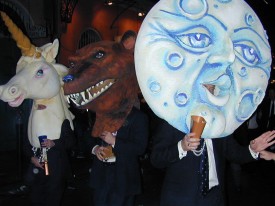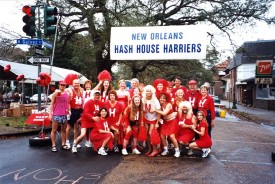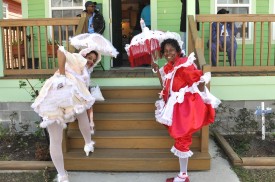Many associations can be made between Mardi Gras and the recreational running and drinking phenomenon known as the “hash.” Both have colorful histories and revel in a spirit of roguish fun, sharing an affinity for inebriation, innuendo and sowing a bit of mayhem. But to truly appreciate the kinship, one must first consider the implications of a seemingly innocuous white powder.
A match made in (hash) heaven
A hare’s flour arrow points Hasherella and her minders to Tropical Isle, site of a “beer check” on the New Orleans Hash House Harriers’ 19th Mardi Gras Madness run
In the context of both Mardi Gras and the hash, the innocuous white powder has been seen by some as a threat to civilized society.
They’re an eyeful coming down the street on the Saturday before Mardi Gras: a rowdy band of running revelers in costume, shouting peculiar utterances and toting go-cups and a blow-up doll affectionately know as Hasherella. In the French Quarter along Bourbon Street, they’ve been known to prostrate themselves before bemused beer deliverymen and proclaim, in mock obeisance, “We are not worthy!” Stopping to regroup every now and then, they down beers and maybe circle-up for bawdy sing-alongs accentuated by synchronized gesticulations, pirouettes and other boozy antics reminiscent of sophomoric rugby rituals.
They are the New Orleans Hash House Harriers (NOH3), a local incarnation of an international recreational phenomenon that’s often described as a “drinking club with a running problem.” Making an inimitable spectacle of themselves on their Mardi Gras Madness hash has been an annual tradition since 1991.
Hashing and Mardi Gras—they go together like champagne and king cake, or big beads and bare breasts. Both revel in a spirit of roguish fun and share an affinity for alcohol, sexual innuendo and sowing a bit of mayhem. In the context of hashing or Mardi Gras, nothing is sacred and nobody is immune to ridicule. To truly enjoy either requires a sense of humor, if not an acute appreciation for the absurd, because you just can’t take yourself too seriously. Indeed, hashing, like Bourbon Street in the thrall of Mardi Gras, is not for the prim or easily offended. Random acts of nudity are sometimes encouraged—and rewarded.
How to explain this kinship? Is it merely derived from an innate human desire to cut oneself loose from the mundane realities of the workaday world? Or is there a more tangible common denominator, a shared ingredient that emerges as a telltale clue?
Exhibit A: the seemingly innocuous white powder otherwise known as flour. It has specific, and at times troublesome, associations with both Mardi Gras and hashing. Some historical perspective:
Before the Civil War, Mardi Gras was quite different from the controlled, rationalized production one sees on the streets today. There were no pre-programmed parades in which masked float riders assumed the role of participatory agents, lording over a general public relegated to the role of spectators. The earliest Carnival “processions,” in fact, were largely impromptu affairs involving bands of revelers rambling through the streets en route to masquerade balls or performances at the French Opera House. On Mardi Gras, elite Creole women would don their finest gowns and ride through the streets in open carriages, throwing bonbons and other treats to gentlemen admirers.
All of which was occurring amidst changing demographic and social conditions; labor unrest, immigration and the influx of transients had a destabilizing effect on the city and its Carnival celebration. Gangs of rowdy revelers took to bombarding maskers and onlookers with flour and lime, prompting newspapers to lament the demise of Carnival. “By the 1850s,” observes William D. Piersen in his book Black Legacy: America’s Hidden Heritage, “it seemed to the French elite of New Orleans that the graceful Parisian style of the city’s Mardi Gras balls and street maskings were being pushed rudely aside by a rabble of flour-throwing African-American and Irish boys whose street brawls and general lower-class impudence had been driving respectable people indoors.”
It was against this backdrop that the Mistick Krewe of Comus emerged in 1857, organizing a scripted parade and private tableau ball. Comus and its kin—other highbrow Carnival organizations, or krewes, that followed in its footsteps—assumed the mantle of cultural white knights whose gallantry and aesthetic vision “saved” the distressed Carnival damsel. In his book Authentic New Orleans: Tourism, Culture and Race in The Big Easy, historian Kevin Fox Gotham cites an 1885 Rand, McNally tour guidebook that references “practical jokes” with lime and flour, which caused the festival to descend into “ruffianism” until receiving its “crowning glory” with the appearance of Comus. He also quotes from a February 1893 article in Harper’s New Monthly magazine that credits the Rex Organization with having “made it possible and advantageous to do away with the promiscuous masking and merrymaking, attendant upon which had been the throwing of lime and flour, the drunkenness, and the usual disorder….” (Rex presented its first parade in 1872, presided over by a monarch of the same name, and quickly became the “main event” of Carnival Day.)
A cross-dressing harrier gets his head examined on Bourbon Street
In laissez-faire New Orleans, the harriers’ deranged antics blend easily with the carnivalesque milieu.
Serving the interests of tourism promotion, this became the “official story” of Mardi Gras and, as Gotham observes, was “passed down through generations in magazines and local newspaper editorials.” So much for the story of an indigenous, racially mixed Latin-Catholic street masking tradition having been effectively usurped by upstart Anglo-Protestants seeking to enhance their social status and cultural power. Instead, according to Gotham, the official version “maintained that the antebellum Carnival was marked by rampant lawlessness, violence and disorder. In response, enlightened citizens formed the elite Carnival krewes to bring order to this chaotic world, tame the unsavory past, and establish a more civil and humane Carnival for the enjoyment of all.”
In this telling, flour became a symbol of degeneracy, transgression and unruliness. It represented, at least at Mardi Gras, a threat to civilized society. To any number of hapless hashers whose use of flour to mark running trails has set off false alarms and even provoked myriad bioterrorism scares, all this will sound familiar.
The markings are crucial because a hash run is like a hunt in which “hares” are assigned the task of picking a route and laying down clues to direct the runners, or hounds. A trail can be pre-laid. Alternatively, for a so-called “live hare” hash, one or two hares get a 15-minute head start and mark the trail on the fly, with the rest of the pack—or at least the front-runners (known as Front-Running Bastards or FRBs)—hustling to chase them down. The trickster hares mix in false decoy trails to bamboozle the pursuers, causing them to have to backtrack. Generally the faster runners ferret out the false trails, thus allowing the laggards to catch up.
Sounds innocent enough; flour is, after all, biodegradable. But alas, the rest of the world doesn’t always understand.
The recurring Mystery of the White Powder
Reporting on hashing for the Contra Costa Times, John Boudreau recounted a 1993 incident involving a hare on a pajama run who was blazing a trail in San Francisco’s Presidio, dropping flour as he went. This was back in the days when the Presidio was military base. “Military police became alarmed. Before long, soldiers, with guns drawn, had him splayed out on the ground. After that his hash name was ‘5150,’ the penal code for a dangerous person with a mental disorder.” (Typically unflattering and off-color, hash nicknames are bestowed by fellow hashers based on a physical feature, personality quirk, innuendo or mishap.)
Running along the New Orleans Public Belt Railroad at Mardi Gras Madness 1998
Hash trails often seem conceived to stoke the irreverent, renegade impulses of runners who have been known to create a pubic nuisance.
Also in 1993, the Dallas Morning News reported that residents of a local neighborhood alerted police after spotting two men with buzz-cut hair acting suspiciously with a power-like substance, handing out beads to children—Mardi Gras beads, no doubt—and “chanting as though they were worshipping some type of god.” One of the men was said to have carried a shrunken head. “Residents told police that they believed the men were skinheads trying to poison children.”
Only the gods who look out for harriers and fools know the full extent of the resources and man-hours that have been devoted to solving the recurring Mystery of the White Power. A sighting in Phoenix in 1997 brought 12 fire engines to the scene, plus a posse of motorcycle police who closed off an area of about two square miles, according to a report in the Arizona Republic. The fire department called in a hazardous-material company to remediate the offending substance.
“Television news reporters reported the white powder crisis as their 5 p.m. lead story on at least two stations,” the newspaper noted. “It led the 10 p.m. news on most stations.”
Late that night, a woman called the fire department and left a message explaining that she was with a “jogging club” and that the mystery power was flour, which had been used to mark a trail for a club event. She apologized, but didn’t leave her name.
Of course, flour is hardly the only reason that hashing is associated with creating a public nuisance. The trails themselves often seem conceived to stoke the irreverent, renegade impulses of the runners, whose antics can stop traffic and draw looks ranging from amused to puzzled, from anxious to alarmed.
It’s all part of the fun and mystique of “the hash” (a catchall term referring to the group and just about everything having to do with its modus operandi). The runners can never be sure where the deranged mind of the hare will take them. Routes can lead through swamps and jungles, briars and brambles as well as storm sewers, railroad tunnels, cow pastures, the lobbies of elegant hotels and department stores, shopping malls, supermarkets, airports, train stations, even the Library of Congress.
This not only offers variety and the opportunity to become intimate with regional geography, but also generates plenty of colorful lore—tales of misadventure and derring-do that are rehashed with guffaws and beers at post-run parties, embellishing the hash’s reputation as “the lunatic fringe of running.” Barbara and Bob Fitz, who founded a hash club in Mount Vernon, VA, in 1986, related to USA Today their experience hashing in Japan one New Year’s Eve. As described by reporter Craig Wilson, “[t]he course took them over a wall, through a public building, and out the other side. Not until they were arrested did they know they were running through an insane asylum.”
“The neighbors thought it was a breakout,” Barbara Fitz explained to Wilson, adding: “A lot of people are very nervous about grown-ups running around having a good time. People have called the police on us a number of times. I fear it’s only a matter of time before someone gets shot.”
Generating a bit of pandemonium has, to be sure, long been a feature of the traditional season of rejoicing preceding the penitential period of Lenten fasting on the Christian calendar. Pre-modern Carnivals in Europe were exhilarating, chaotic affairs in which traditional hierarchies and laws were suspended and the common folk ran wild in the streets, indulging in insubordination and merry mockery at the expense of the ruling elites.
Hashing is similarly cathartic—a subversion of the competitiveness and rules-oriented culture of corporate-sponsored road races. But the hash is, first and foremost, a social event; most people join a hash club for the camaraderie. The same can be said for Mardi Gras krewes.
Comus krewemen, with cowbells, on Fat Tuesday 2002
The prototypical New Orleans Mardi Gras krewe, Comus is forever indebted to Michael Krafft, founder of Mobile’s Cowbellion de Rakin Society and the archetypal reveler-ringleader of Gulf Coast Mardi Gras.
Lords of merriment, mayhem and misrule
Carnival historians often point to the Cowbellion de Rakin Society as the progenitor of the krewe system. On a rainy Christmas Eve night in 1831, in Mobile, Ala., a cotton broker named Michael Krafft—described in a contemporary account as “a fellow of infinite jest and…fond of fun of any kind”—apparently found himself in the doorway of a hardware store, quite likely intoxicated. He gathered up a string of cowbells and attaching them to the teeth of a rake, went on his merry way, clattering. According to an account of the night’s events cited by Carnival historian Samuel Kinser, in his book Carnival, American Style, Krafft, having drawn a crowd, caught the attention of a passer-by who exclaimed, “ ‘Hello, Mike—what society is this?’ Michael, giving his rake and extra shake and looking up at his bells, responded, ‘This? This is the Cowbellion de Rakin Society.’ ”
That may be folklore. But in any case, on subsequent rambles. Krafft was joined by other “Cowbellions,” and the group went on to become Mobile’s premiere Carnival organization, sponsoring New Year’s Eve masquerades and even venturing to New Orleans in the late 1830s to partake in Mardi Gras. In 1840, the krewe presented its first parade with floats depicting a specific theme: “Heathen Gods and Goddesses.” A masked ball followed.
Some of the founders of the prototypical New Orleans Mardi Gras krewe, Comus, had ties to Mobile and the Cowbellion de Rakin Society. The Comus krewemen, moreover, are said to have borrowed costumes from the Cowbellions for their inaugural Mardi Gras pageant, in 1857.
If the Mardi Gras spirit is defined as an enduring human capacity for merriment and make-believe, for mirthful foolery and the creative indulgence of whimsy, then Michael Krafft stands as its mythic personification. The archetypal reveler-ringleader, a New World Lord of Misrule, his waggish flamboyance was at the very core of the cultural enterprise that became Gulf Coast Mardi Gras.
Like Mardi Gras, the hash has a colorful history, is rich in tradition and lore, and boasts a sainted founder-figure—Albert Stephen (A.S.) Ignatius Gispert. An Englishman of Spanish descent, he can be seen as a kindred spirit of Krafft, and would probably have heartily concurred with the motto of one of the early New Orleans Mardi Gras krewes, the Phunny Phorty Phellows: “A little nonsense now and then is relished by the best of men.”
An expatriate accountant and volunteer British military reservist, Gispert was initiated into the sport that would become known as hashing while stationed in Malacca, in 1937. He joined a club called the Springgit Harriers, whose runs were based on the old game known as Hares and Hounds or the Paper Chase. The rules would call for one member of the group (the hare) to take off ahead of the others (the hounds) and leave behind a trail marked with shredded paper. The hounds, also known as harriers, would then bring chase, hoping to “capture” the hare before he finished the trail.
Variously described as “unathletic” and “rotund, jolly,” Gispert, known as “G,” was not the front-running type. But the thrill of the chase on a surprise-filled trail must have caught his fancy, for when he moved to Kuala Lumpur, Malaya (now Malaysia) in 1938, he rallied a group of fellow expatriates to form a new outfit.
Administering libations
on Bourbon Street
This “drinking club with a running problem” has an affinity for naughtiness and sowing a bit of mayhem.
They congregated at the Selangor Club, a colonial outpost known as the “Hash House” for its unimaginative food. When the Registrar of Societies required that the runners’ endeavor be legally registered, Gispert is said to have proposed the name Hash House Harriers.
In 1986, the late Hash House Harrier historian Tim “Magic” Hughes asked one of Gispert’s original cohorts, Frederick “Horse” Thomson, what was written on the original charter for the club.
“We had to fill in all these forms,” Thomson recalled. “It was really a pain in the ass. The HHH had no rules, membership and dues. Cecil Lee [another co-founder] and I conferred, and wrote down on the application: The reason for the Hash is to get as pissed as possible, in as many local Chinese suburbs of Kuala Lumpur as often as possible.” (In the lexicon of the hash, “pissed” is a synonym for “drunk”.)
After meandering through such environs, as well as rubber tree and palm oil plantations, the hash ended with a bash—regardless of whether or not the harriers had succeeded in chasing down a hare. Rituals involving beer and randy rugby songs animated the festivities.
The Hash House Harriers (aka HHH or H3) celebrated their 100th run on August 15, 1941. The Japanese arrived shortly thereafter, and the hash went into hibernation as Word War II raged. Alas, Gispert didn’t live to see its revival or eventual fluorescence into a global legacy. He was killed in action in Singapore on February 11, 1942, at age 38. (Cecil Lee would later recall that when the surviving members returned to Kuala Lumpur after the war, the recreation of the HHH came about primarily as a tribute to the memory of Gispert—“a man of great wit and charm.”)
While running and revelry defined the hash from the outset, a 1950 Kuala Lumpur HHH registration card spelled out more specifically the club’s raisons d’être: to encourage physical fitness amongst our members; to get rid of weekend hangovers; to acquire a good thirst and to satisfy it in beer; and to persuade older members that they are not as old as they feel.
By the 1960s, the hash had begun to spread like a tropical contagion through the British Commonwealth. It became a popular way for expatriate businessmen, diplomats and military personnel to network and blow off steam. The number of affiliates snowballed in the 1980s and early 1990s. Today, there are over 1,700 chapters, or kennels, worldwide.
Whether you’re in rice paddy in Thailand or a subway station in Manhattan, there’s always a chance you’ll happen across a pack of footloose runners communicating in a strange verbal shorthand. Those toward the back of the pack often bellow, “Are you?” as in “Are you on the trail?” If the scouts up ahead haven’t yet found the right mark, they’ll shout “Checking!” “On-on!” is the distinctive cry heard when runners are on the correct trail. The discovery of the telltale mark indicating the correct trail may be heralded by whistles, trumpets and other noise-makers.
Submitting to the spirit of the occasion
“Looters with Hooters ” in the French Quarter, on the first Mardi Gras (2006) after Hurricane Katrina
In the realm of Mardi Gras and the hash, satire, political incorrectness and racy fantasies are gleefully, and sometimes obsessively, dramatized.
As the footprint of the hash has grown to span the globe, Mardi Gras has evolved from a local celebration for residents into an iconic, internationally recognized spectacle that encompasses and expresses all that New Orleans essentially is. There has been a huge expansion in the annual number or parades, media coverage, tourist interest and money spent in connection with the festivities. Consequently, as historian Gotham has observed, the Mardi Gras “experience” has become more accessible to outsiders and, in the process, increasingly associated with mass entertainment and consumer culture. The Mardi Gras “theme,” synonymous with fun and festivity, has been embraced by casinos, theme parks, event planners, restaurants and liquor companies. Meanwhile, annual Gulf Coast-style Mardi Gras celebrations have taken root in such places as Washington, D.C., Snowmass, CO, Deadwood, SD, San Diego, CA, and Norman, OK, not to mention London and Sydney.
Although hashing and Mardi Gras can seem incomprehensible to the uninitiated, given their peculiar customs and lingo, both share an openness to newcomers. The only requirement is a willingness to submit to the spirit of the occasion. As one HHH motto says: “If you’ve half a mind to join the hash, that’s all you need!”
Mardi Gras still has its exclusive realm of elite krewes and balls revolving around Carnival courts and high-society debutantes. But the city of New Orleans, in its tourism marketing campaigns, has sometimes seemed like a solicitous jester with a sparkle in his eye and welcoming arms extended, playing up the notion of Mardi Gras as “The Greatest Free Show on Earth.”
In truth, there’s much more to Mardi Gras than fancy-dress balls, glitzy parades and flesh-baring exhibitionism on Bourbon Street. Existing on margins is a veritable cornucopia of “unofficial,” grassroots processions and presentations that, collectively, represent an authentic and compelling expression of indigenous folkways.
Just as Mardi Gras is more than just an excuse to party, hashing is more than just a sport. It can become a way of life, inspiring an almost religious devotion. Some hardcore harriers are like gypsies, planning vacations around hashing and making pilgrimages to run and quaff with hash clubs in foreign lands.
People do tend to get obsessive about it. Couples have hash weddings. Alter egos are nurtured in an atmosphere of collective lunacy in which inhibitions are gleefully forsaken. “It’s like a controlled craziness—a sort of semi-controlled craziness,” Pam Semon, a San Diego hasher, explained to Hilary Stout of the Wall Street Journal.
Mardi Gras, too, is a time to indulge obsessions and partake in communal manias. The spectacle surrounding throws—beaded necklaces and other paraphernalia tossed to Mardi Gras revelers from balconies and parade floats—is one obvious manifestation. But for many New Orleanians, costuming is the ultimate expression of Mardi Gras Madness—the apotheosis of a self-dramatizing culture, in which creative expression through theatricality and masquerade is a consuming passion and a way of life.
As one local expert told Carol Flake, author of New Orleans: Behind the Masks of America’s Most Exotic City, New Orleanians “are always in the process of creating a new persona or honing and adding facets to what they have.” The act of costuming is known as “masking,” regardless of whether an actual mask is worn. By simultaneously concealing a person while creating a new persona, masking makes possible an escape into a world of fantasy.
Group costumes have long been a popular Mardi Gras tradition. It is most compelling when friends and family members, rather than becoming mere clones of one another, come up with individualized takes on a common theme.
In 1852, a group known as the Company of Bedouins were got up as camels and Arab nomads. History also records that the inaugural Comus parade, entitled “The Demon Actors in Milton’s Paradise Lost,” featured a hoard of masked devils. Later, in a more topical vein, the exploits of Teddy Roosevelt and his Rough Riders provided thematic fodder. Perennial favorite motifs include cocktails, pirates, clowns, harlequins and sailors.
A rambunctious lot with a flair for the outlandish, hashers also have an affinity for themes and costuming. Risqué affairs involving cross-dressing, such as Pink Tutu, Lingerie and Red Dress runs, are particularly popular.
NOH3 in the early days of the Red Dress Run
In a city renown for merriment and masquerade, the event has become a hugely popular charity fundraiser.
The Hash House Harriers’ most enduring contribution to group costuming, the Red Dress Run originated in San Diego in the mid-1980s, as one story goes, after a woman in a red dress made an impression at a post-run party. “She apparently had deliciously low moral standards and caught the attention of several male hashers with whom she later arranged a rendezvous or two or three,” a hasher known as Anal*izer explained to Jim Uschold of Skat magazine. “In order to inspire her to attend the next hash run, they decided everyone would wear red dresses in her honor. Their plan worked.”
A more standardized version holds that a newcomer in San Diego was invited to a hash. Not knowing it was a running group, she showed up in a red dress, and was mocked. But she ran the trail anyway, inspiring other hashers to don red dresses as a joke.
Now a venerable tradition, annual Red Dress Runs have been adopted by hash clubs around the world as charity fundraisers. But it should come as no surprise that the biggest one occurs in New Orleans, a city where eccentricity is a civic virtue and cross-dressing, especially during Carnival, has long been taken for granted. Indeed, in early krewe tableau productions—staged performances featuring representations of a chosen theme—“every female character was brought to life by an all-male cast; no matter how delicate or feminine some costumes may appear, they were worn with delight by generations of the most prominent businessmen of New Orleans,” writes Henri Schindler in Mardi Gras Treasures: Costume Designs of the Golden Age.
Tremé Million Dollar Baby Dolls on Carnival Day 2009
Sharing an affinity with Red Dress hashers for titillation and transgression.
The 2009 New Orleans Red Dress run drew some 5,000 participants. Judging from the skimpy finery on display, the reveler runners appeared to channel inspiration from Mardi Gras Baby Dolls, an informal African-American sisterhood who dress in frilly, sexually titillating Baby Doll outfits—typically, short skirts, bloomers, satin blouses and bonnets tied under their chins with ribbons. Like the Red Dress runners of today, Baby Dolls of yore were known for ribaldry (some hailed from New Orleans’s rough-and-tumble Uptown red-light district). They sought “kicks and tricks” on Carnival Day, when male revelers came around looking for action and would stuff money into the girls’ stockings. Baby Doll masking caught on, enabling women from various walks of life to publicly partake in festive transgression—flaunting or mocking conventional expectations that required them to suppress their sexuality.
The New Orleans Red Dress event is a veritable frenzy of festive transgression, attracting a tarted-up multitude of pseudo-harriers and hash virgins, sometimes referred to as “new boots,” who don’t so much decipher a trail as get swept along with the stumbling herd. No matter that most of these neophytes wouldn’t know a “live hare” hash from a “butt chug” (don’t ask).
Like Mardi Gras, the hash attracts more than its share of inebriants, iconoclasts and exhibitionists. But many are regular professional types one wouldn’t typically associate with outrageous behavior and extreme forms of escapism.
Mardi Gras revelers run the gamut. There are passionate artisans who spend countless hours creating mind-blowing regalia, and dedicated pleasure-seekers who engage the festivities with the fervor of Romans at a bacchanal. Celebrities appear in parades as special guests, while college co-eds enact the rituals of Spring Break. For some locals, the festivities are merely an excuse to party at parade picnics with friends and family.
Drinking and jesting
In the realm of the hash, the usual social hierarchies are suspended and there’s not much concern for what fellow harriers do in the “real world.” Like a masker at Mardi Gras, you can be whoever you want to be. Hardcore runners who hotly pursue hares happily coexist with “walkie-talkies,” aka the “knitting circle”—chit-chatting idlers who bring up the rear of the pack, barely breaking a sweat.
A congenial potpourri of humanity, Mardi Gras also offers an escape from rigidly defined roles and boundaries. Although the distinctions of class, color and culture are never far below the surface, and may even be overtly referenced in costuming, masking makes possible flights of fancy into a world of joyous license, where the usual categorizations and distinctions are temporarily irrelevant.
That said, the amalgamation of crazy habits and rituals associated with Mardi Gras and the hash are not without structure. Indeed, everything occurs within a framework of established conventions. As a collection of reference points, the respective frameworks are highly malleable, allowing for plenty of variation. So while Mardi Gras krewes have their own unique identities and traditions, hash clubs have own personalities and adaptations of bedrock rituals. Some clubs are PG-rated and offer fun for the whole family. Others are big on shenanigans and beer drinking—before, during and after the run. And still others pride themselves on arduous runs featuring lots of “shiggy”—hash lingo for thick vegetation, streams, rocks, muck and other challenging conditions that appeal to a certain breed of bushwhacker-hasher.
Krewes and hash clubs operate as non-profit organizations, with positions of responsibility for getting things done. The big cheese in a krewe is the captain, who is ultimately responsible for managing and directing krewe activities. His ancestor is the Lord of Misrule. As James Gill explains in his book Lords of Misrule: Mardi Gras and the Politics of Race in New Orleans, this was the name was given to “the humorous fellow who organized revels from Christmas to Twelfth Night in the great houses of Europe.”
Hash clubs have “mismanagement.” The lord of mismanagement is the Grand Master, who, according to a list of job descriptions posted on Harriers.net, is not only the figurehead and guiding light but also “personifies the hash’s character (of lack thereof).” It says something about the nature of the hash that the Grand Master/Mistress is often regarded as a position of inferior importance to that of the Beermeister, who must keep the suds flowing or suffer perilous ignominy.
For beer is the mother’s milk of the hash just as surely as all hash clubs are the progeny of Gispert’s Malaysian “Mother Hash.” Knowing that a trail will sooner or later lead to beer is, no doubt, reason enough to follow it.
Typically, a trail will include a pit stop where runners rendezvous for refreshment, known as a “beer check.” Like yelping hounds picking up the scent on a foxhunt, harriers know their quarry is close at hand when they encounter a particular trail marking—“BC.” Its discovery invariably elicits jubilant cries of “Beer near!” as the word is passed down through the pack.
Although hashing is closely associated with beer, just as Mardi Gras has a reputation for mass inebriation, swilling intoxicants isn’t required. Indeed, in hash drinking rituals, substituting water or other non-alcoholic beverages will not bring derision. Thus, a teetotaler with a bent sense of humor and a love of running and socializing can feel perfectly at home in the hash. And if welcoming non-drinkers means more beer to go around for everyone else, so much the better.
A proud winner shows off his NOH3 Mardi Gras Madness trophy emblazoned with second-lining hare
In the Hash Circle, awards are bestowed and punishments meted out in an atmosphere of outlandish hilarity.
Beer is the traditional sacrament in the quasi-religious ceremonies that take place after the run. Variously known as the “après,” “on-after” and “down-down,” the festivities are presided over by an emcee—usually the Grand Master/Mistress or the so-called Religious Adviser, or RA—who is responsible for contriving outlandish reasons to bestow awards and mete out punishments. Honorees and culprits share the same fate: a compulsory chug known as a “down-down.” If the drinker can’t drain the beverage in one continuous suckdown, protocol may require that the remainder be poured over his or her head.
The zany slapstick of the Hash Circle, in which down-downs are administered, takes a page or two from post-game rugby rituals. Normal standards of good taste do not apply, and otherwise inappropriate behavior comes off as entertaining. Politically incorrect insults, juvenile initiation rites and off-color songs about drinking and sex are all part of the merriment. Depending on the customs of the presiding hash club, a new initiate might wind up sitting bare-assed on a block of ice or drinking beer from a running shoe, while encircled by a boisterous crowd hollering, “Drink it down, down, down!”
Jesting and drinking, and testing the limits of decorum (at least in the notoriously permissive atmosphere of the French Quarter), are also very much a part of Mardi Gras. In fact, hashing behavior that in other cities might be considered gonzo can seem positively normal amid the frenzied frivolity of Mardi Gras.
For one thing, revelers take full advantage of the city’s famously relaxed laws that allow drinking in public year round. Markets and drugstores sell liquor at all hours, cans of beer packed in ice beckon from gas-station bins, and some bars never close their doors. There are even bars that double as laundromats.
To the wide-eyed tourist from Straightsville or the buttoned-down conventioneer unschooled in the carnivalesque culture of New Orleans, the disheveled bloke holding a “Huge Ass Beers To Go” placard on Bourbon Street might seem the very caricature of vulgarity and excess. Ah, but in the eyes of a hasher, he is likely to regarded as a prophet or oracle sent by the Hash Gods to enlighten benighted mortals.
If it’s shiggy you crave, Mardi Gras offers its own unique blend. One Unofficial Guide to Hash Lingo defines shiggy this way: “Usually wet, muddy, toxic, bad-smelling, difficult or all of these things.” During the height of Mardi Gras, Bourbon Street, overflowing with sticky go-cups, stale beer and other malodorous detritus, satisfies virtually all of these criteria.
Then there are all those heroic beer deliverymen, so worthy of approbation. Alas, one can only conclude that Mardi Gras isn’t merely an epic party. It may just be the closest thing to Hash Heaven on Earth.
MardiGrasTraditions.com

